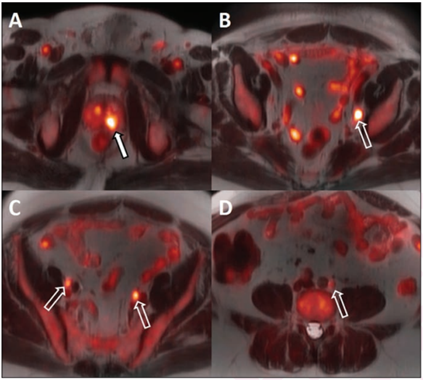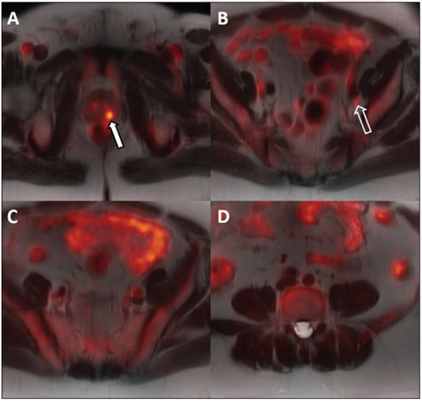PET/MRI Boosts Prostate Cancer Staging and Hormone Therapy Evaluation
18F-fluciclovine PET/MRI can improve treatment guidance with better staging and evaluation of androgen deprivation therapy.
Adding to evidence revealed earlier this week, a new study shows that fluorine-18-labeled fluciclovine (18F-fluciclovine) PET/MRI does at better job at staging high-risk prostate cancer – and it can more accurately assess how a patient is responding to androgen deprivation therapy (ADT).
In a small study of 14 men who received new diagnoses of high-risk prostate cancer who also had negative or equivocal conventional staging imaging, researchers from the University of Alabama at Birmingham (UAB) revealed multiple benefits of using 18F-fluciclovine – outcomes that support expanding clinical use of the radiotracer.
The team, led by Samuel Joseph Galgano, M.D., director of abdominal imaging at UAB, published their findings in the Oct. 27 American Journal of Roentgenology.
Related Content: PET-Enhanced MRI is “Best Available Test” to Guide Recurrent Prostate Cancer Treatment
“Our study results support the potential utility of 18F-fluciclovine PET in initial staging when compared to conventional imaging with superior detection of extraprostatic disease,” the team said. “Additionally…18F-fluciclovine PET/MRI offers far superior intraprostatic lesions characterization and local staging of the prostate when compared to PET/CT.”
64-year-old man with biopsy-proven Gleason 4+5 in the left base and serum prostate specific antigen. Courtesy: American Journal of Roentgenology

Prostate cancer is the leading cause of cancer-related death among American men, and up to 30 percent of patients can experience biochemical recurrence. Consequently, the team said, providers need improved imaging that can better guide their treatment decisions to limit these types of recurrences.
To determine how well 18F-fluciclovine performs in this role, the team captured 18F-fluciclovine PET/MRI studies with a 3T Signa scanner on all patients from January 2018 to February 2019. Each patient received the standard 370 MBq intravenous dose of the radiotracer. Based on patient data gathered at the beginning of the study, 21 percent of patients had an average predicted risk of lymph node metastases.
Same patient after six weeks of androgen deprivation therapy and decrease in serum prostate specific antigen. Courtesy: American Journal of Roentgenology

According to the team’s findings, the biopsy-proven lesions in the prostate gland of all patients were accurately identified on both MRI and 18F-fluciclovine PET/MRI. Additionally, the activity detected on PET/MRI correlated with both the MRI-defined intraprostatic lesions and biopsy-proven prostate cancer.
Among the patients, PET/MRI caught suspected pelvic regional nodal metastases in seven patients while MRI did so in only three. Of those three patients, though, 18F-fluciclovine PET/MRI was concordant for lymph node metastases and found additional suspected lymph node metastases not detected by MRI used alone.
“Detection of these lymph nodes during initial staging may have important consequences for surgery or radiotherapy planning,” the team said.
In fact, they said, their findings add to existing evidence that shows 18F-fluciclovine PET/MRI outperformed both MRI and PET alone in distinguishing between malignant and benign tissue, as well as high-grade tumors from other tissues.
The team also assessed how well 18F-fluciclovine assessed patient response to ADT. Of the 14 participants, 10 underwent ADT before having radiation therapy. All 10 patients received an accurate identification of the primary intraprostatic lesion, and seven of these patients demonstrated suspicious lymph nodes on pretreatment PET/MRI. After completing ADT, every participant experienced a drop in tracer activity either with the primary intraprostatic lesions, all suspicious lymph nodes detected on pretreatment 18F-fluciclovine PET/MRI or both.
Specifically, they found the primary lesion SUV mean was 4.5 +/- 1.1 before treatment and 2.4 +/- 1.1 after initiating ADT. For suspicious lesions, the pretreatment SUVmax was 5.5 +/- 3.7, and posttreatment, it was 2.8 +/- 1.4.
“After ADT, patients consistently demonstrated decreases in serum PSA, as well as decreases in 18F-fluciclovine uptake in primary prostate cancer and nodal metastases,” they said. “Thus, 18F-fluciclovine PET imaging may be useful in monitoring response to ADT, particularly if there is a failure of expected PSA decline after therapy.”
Although the study size was small, the team said, these findings – and the existing approval from the U.S. Food & Drug Administration (FDA) –suggest this radiotracer stands at the ready to make a significant clinical impact.
“Given the FDA approval of 18F-fluciclovine,” they concluded, “this study could have widespread impact in the immediate future, guiding initial management of patients with prostate cancer.”
For more coverage based on industry expert insights and research, subscribe to the Diagnostic Imaging e-Newsletter here.
Can Abbreviated MRI Have an Impact in Rectal Cancer Staging?
April 4th 2025Abbreviated MRI demonstrated a 95.3 percent specificity for rectal cancer and provided strong agreement with the full MRI protocol for T staging and detection of extramural venous invasion, according to newly published research.
GE HealthCare Debuts AI-Powered Cardiac CT Device at ACC Conference
April 1st 2025Featuring enhanced low-dose image quality with motion-free images, the Revolution Vibe CT system reportedly facilitates improved diagnostic clarity for patients with conditions ranging from in-stent restenosis to atrial fibrillation.